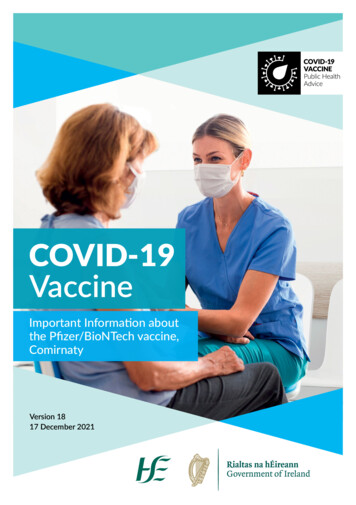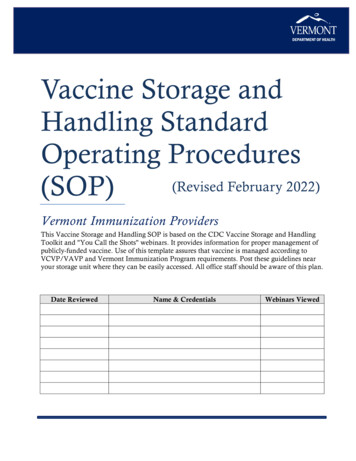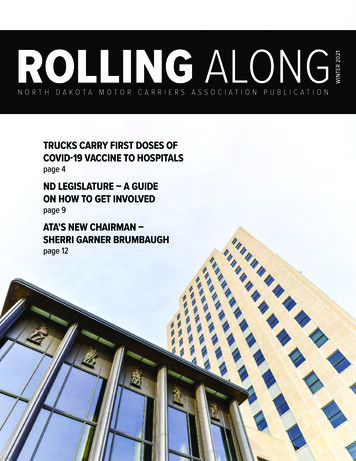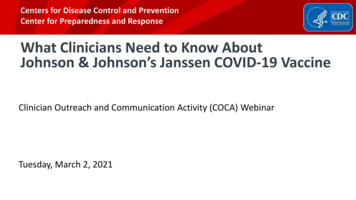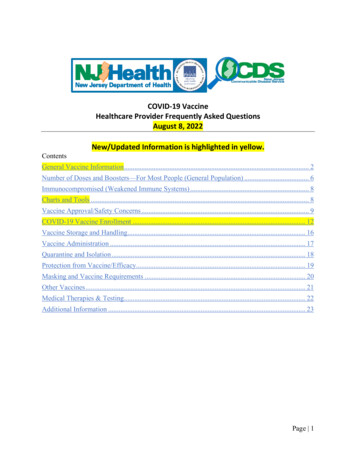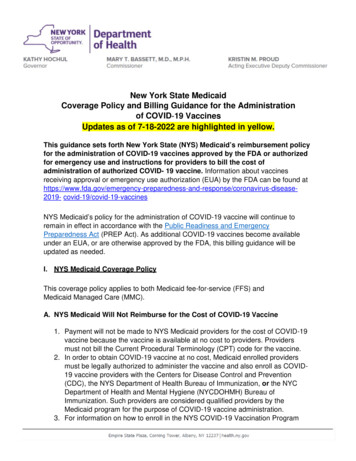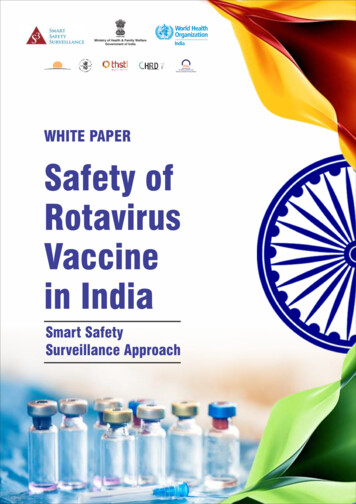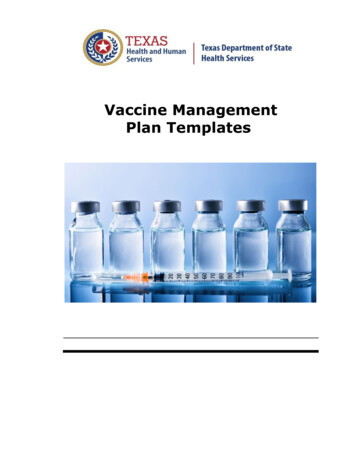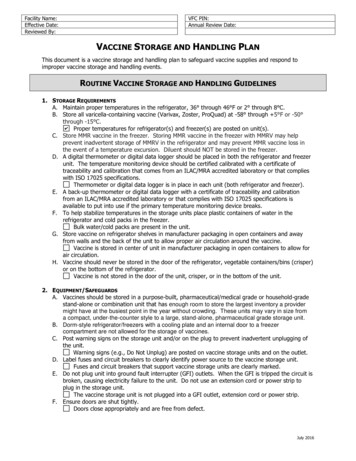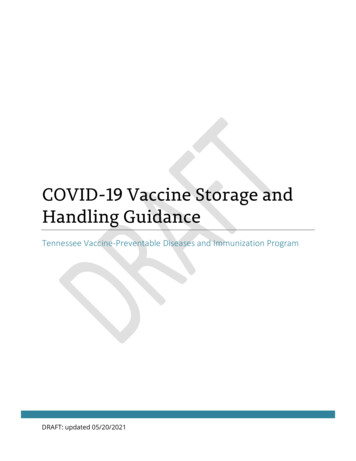
Transcription
COVID-19 Vaccine Storage andHandling GuidanceTennessee Vaccine-Preventable Diseases and Immunization ProgramDRAFT: updated 05/20/2021
1ContentsSection One: Introduction . 3Section Two: Staff and Training . 4Section Three: Equipment. 5Vaccine Storage Unit Recommendations. 5Temperature Monitoring Devices (TMD) . 6Monitoring Vaccine Temperature and Equipment . 8Power Supply. 9Organizing and Storing Vaccine . 9Regular Maintenance of Equipment. 10Section Four: Pfizer/BioNTech COVID-19 Vaccine Storage. 10Using the Thermal Shipping Container for Vaccine Storage . 10Using an Ultra-cold Freezer for Vaccine Storage . 11Using a Freezer for Vaccine Storage. 12Using a Refrigerator for Vaccine Storage . 13Section Five: Moderna COVID-19 Vaccine Storage . 13Using a Freezer for Vaccine Storage. 13Using a Refrigerator for Vaccine Storage . 14Section Six: Janssen COVID-19 Vaccine . 14Using a Refrigerator for Vaccine Storage . 14Section Seven: Temperature Excursions (TEs) . 15Section Eight: Vaccine Inventory Management . 16Scheduling and Receiving Deliveries . 16Unpacking Deliveries . 16Stock Rotation and Removal . 17Preparing Vaccines for Administration . 17Section Nine: Vaccine Transport . 17Vaccine Transport to Offsite PODs or Mobile Clinics . 17Emergency Vaccine Transport . 18DRAFT: updated 05/20/2021
2Planning and Preparing for Transport . 19Monitoring Temperatures During and After Transport. 19Section Ten: Emergency Vaccine Storage and Handling . 19Alternative Storage Facility . 20After Hours Facility Access . 20Appendix A: Routine and Emergency Vaccine Management PlanAppendix B: COVID-19 Refrigerated Transport LogDRAFT: updated 05/20/2021
3Section One: IntroductionVaccines must be stored and handled properly in order to prevent and eradicate vaccinepreventable diseases. Failure to properly store and handle vaccines results in financial loss,revaccination, and reduced public confidence in vaccines. Vaccines that have been exposedto improper conditions have reduced potency, resulting in inadequate immune responseand poor protection against disease.The temperature-controlled environment used to maintain andtransport vaccines in optimal condition is called the vaccine coldchain. The cold chain begins with the storage unit at theAn effective vaccinecold chain relies on manufacturing plant, extends to the transport and delivery ofvaccine and storage at a clinic, and ends with administrationof the vaccine to a patient.Every time a vaccine is exposed to improper conditions (e.g.,overexposure to heat, cold, or light), its potency is reduced.If a refrigerated vaccine is exposed to freezing temperaturejust once, its potency can be destroyed.This document is designed to assist providers in properlystoring and handling federal COVID-19 vaccine as part of theTennessee Vaccine-Preventable Diseases and ImmunizationProgram (VPDIP) COVID-19 Vaccination Program. It is amodified version of the Centers for Disease Control andPrevention (CDC) Storage and Handling Toolkit, which youare highly recommended to review in order to fullyunderstand the breadth of information, recommendations, and resources available toassist you in properly storing and handling your vaccine supply. CDC’s You Call the ShotsModule Ten is also a recommended training for understanding vaccine storage andhandling.Always refer to the manufacturer information and package inserts or contact themanufacturer directly for detailed storage and handling protocols for individual vaccines.The Tennessee Department of Health are not authorized to assess, validate, verify, or endorse products orservices of private companies. When purchasing storage and handling equipment, keep in mind that productslabeled as “CDC-compliant” have not been reviewed by the CDC or the Tennessee Department of Health.Always contact the Tennessee Vaccine-Preventable Diseases and Immunization Program if you are unsure if aspecific product meets requirements.DRAFT: updated 05/20/2021
4Section Two: Staff and TrainingClearly written, detailed, and up-to-date storage and handling standard operatingprocedures (SOPs) will help your facility stay organized, serve as a reference and trainingtool, and assure proper vaccine management. SOPs should be maintained near vaccinestorage units where staff can find them. Additionally, well-trained staff are necessary forimplementing SOPs at the facility. Staff should be trained on storage and handlingprocedures as part of new employee orientation, annually, whenever new vaccines areadded to the inventory, and whenever storage and handling recommendations change. Atemplate Routine and Emergency Vaccine Management Plan (REVMP) may be found inAppendix A.At a minimum, SOPs should contain plans and information for three major areas:1) General: contact information for vaccine manufacturers, equipment serviceproviders, and important facility staff; job descriptions; regularly used forms; andstaff training requirements2) Vaccine inventory management: ordering vaccines, monitoring storage, etc.3) Emergency: steps to take in the event of equipment malfunctions, power failures,or other emergencies that can compromise storage conditionsA primary vaccine coordinator should be designated for ensuring all vaccines are storedand handled correctly. A back-up vaccine coordinator should also be appointed to act inthe absence of the primary coordinator. Both coordinators should be responsible for: Ordering vaccine (once available) and overseeing receipt/storage of deliveries Maintaining all documentation, such as vaccine inventory and temperature logs Monitoring operation of vaccine storage equipment and systems Organizing vaccines in storage units, including rotating stock at least weekly sovaccines with earlier expiration dates are used first and removing expired vaccines Monitoring temperature data on storage units, including:oSetting up temperature monitoring devices (TMDs)oChecking minimum/maximum temperatures for the last 24 hours in themorning and checking current temperatures in the morning and afternoonoReviewing temperature data weekly for shifts in temperature trendsoResponding to and reporting temperature excursions Organizing vaccine-related training and ensuring staff complete training Overseeing vaccine transport when necessaryDRAFT: updated 05/20/2021
5 Overseeing emergency procedures, such as tracking inclement weather conditionsand ensuring appropriate handling of vaccines during a disaster or power outageVPDIP requires completion of CDC’s COVID-19 Vaccine Training Modules for all primary andback-up coordinators at all sites enrolled in the COVID-19 Vaccination Program.Pharmacists signing the Storage and Handling portion of the COVID-19 Provider Agreementare also required to complete the training modules. Continuing Education Units (CEUs) areavailable upon completion of each module and must be provided to VPDIP for review.Current training modules are listed below and may be found on CDC’s COVID-19 VaccineTraining Modules Homepage. COVID-19 Vaccine Training: General Overview of Immunization Best Practices forHealthcare Providers Janssen COVID-19 Vaccine (Johnson & Johnson): What Healthcare ProfessionalsNeed to Know Moderna COVID-19 Vaccine: What Healthcare Professionals Need to Know Pfizer-BioNTech COVID-19 Vaccine: What Healthcare Professionals Need to KnowSection Three: EquipmentVaccine Storage Unit RecommendationsPurpose-built or pharmaceutical grade units are designed specifically for storingbiologics such as vaccines. These units: Can be compact, under-the-counter style or large Often have microprocessor-based temperature control with a digital temperaturesensor (thermocouple, resistant temperature detector [RTD], or thermistor) Often have fan-forced air circulation with powerful fans or multiple cool air ventspromoting uniform temperature and fast temperature recovery from an out-ofrange temperatureHousehold grade units can be an acceptable alternative under the right conditions. Whenusing these units, the freezer compartment of a combination unit should never beused to store vaccines, and certain areas of the refrigerated compartment should beavoided as well. Separate standalone freezers are necessary for storing frozenvaccine.If a manual defrost freezer is used, an appropriate back-up freezer must be available tostore vaccine in when the main freezer is being defrosted. A defrost plan should beDRAFT: updated 05/20/2021
6included in the storage and handling SOPs, and the unit should be defrosted when the unithas accumulated to a thickness of approximately 1 cm.Dormitory-style and bar-style units may never be used to store vaccine. These unitshave a single external door and evaporator plate (cooling coil) that is usually located in the“freezer” within the refrigerator. These units place vaccine at high risk of freezing.Storage Unit PlacementVaccine temperature stability requires air circulation around the outside of the storageunit. Recommendations for where to place refrigerators and freezers include: Unit should be in well-ventilated room with standard room temperatures (between20 C and 25 C [68 F and 77 F]) and space between the unit, ceiling, and walls Nothing should block the cover of the motor compartment Unit should be firm and level, with bottom of unit above floor Door should be able to open and close smoothly and fit squarely against unit bodyStabilizing Temperatures in New and Repaired UnitsPrior to storing vaccines in a new or repaired unit, check and record the minimum andmaximum temperatures each workday for two to seven days. Once you have twoconsecutive days of temperatures within the recommended range, the unit is stable andcan be used for vaccine storage.Recommended Temperature RangesDifferent COVID-19 vaccines have different recommended temperature ranges.Refrigerated vaccines should be stored in refrigerators maintained at temperaturesbetween 2 C and 8 C. Frozen vaccines should be stored in freezers maintained attemperatures between -25 C and -15 C. Ultra-cold vaccines should be stored in freezersor dry ice shipping container in which product is received between -95 C and -60 C.Temperature Monitoring Devices (TMD)All storage units must be equipped with a specific type of TMD known as a digital datalogger (DDL). DDLs provide details on all temperatures the unit has reached at presetintervals. DDLs should have the following features: Detachable, buffered probe (or digitally buffered device that mimics buffered probe) Alarms (audible or visual) for out-of-range temperatures, with parameters set as:oRefrigerator low alarm (too cold) set to trigger after 15 consecutive minutesor longer below 2.0 CDRAFT: updated 05/20/2021
7oRefrigerator high alarm (too warm) set to trigger after 60 consecutiveminutes or longer above 8.0 CoFreezer high alarm (too warm) set to trigger after 60 consecutive minutes orlonger above -15 C Low-battery indicator Active display outside of unit that allows current, minimum, and maximumtemperatures to be monitored without opening unit door Recommended uncertainty of /- 0.5 C Logging interval (or reading rate) that can be programmed by the user to measureand record temperatures at least every 30 minutes Ability to easily download data for review Ability to report temperatures in Celsius A current and valid Certificate of CalibrationA back-up DDL with a valid and current Certificate of Calibration must also beavailable on-site and readily available in case a primary DDL malfunctions or requires recalibration. The back-up DDL should be stored outside of the storage unit until needed,and it should have a different calibration re-testing date than the primary DDLs so that onemay be used while the other is being replaced or sent out for re-calibration.Certificate of Calibration TestingCalibration testing ensures the accuracy of DDLs against nationally accepted standards.Calibration testing should be done every one or two years or according to themanufacturer’s suggested timeline. Certificates of Calibration testing should indicate one ormore of the following about the testing: Conforms to International Organization for Standardization (ISO)/InternationalElectrotechnical Commission (IEC) 17025 international standards for calibrationtesting and traceability Performed by a laboratory accredited by International Laboratory AccreditationCooperation (ILAC) Manual Recognition Arrangement (MRA) signatory body Traceable to standards maintained by the National Institute of Standards andTechnology (NIST) Meets specifications and testing requirements for the American Society for Testingand Materials (ASTM) Standard E2877 Tolerance Class F or higher Refers to another acceptable accuracy validation method, such as comparison toother traceable reference standards or tests at thermometric fixed pointsCertificates of Calibration Testing should also include:DRAFT: updated 05/20/2021
8 Model/device name or number Serial number Date of calibration (report or issue date) Confirmation that the instrument passed testing (or instrument is in tolerance) Recommended uncertainty of /- 0.5 C ( /- 1 F) or lessThe following TMDs should not be used Alcohol or mercury thermometersBimetal stem TMDsTMDs used for foodChart recordedInfrared TMDsTMDs that do not have a current and valid Certificate of Calibration testingTemperature Probe PlacementThe DDL probe should be placed in the middle area of the storage unit with the vaccines.Anchoring the probe will prevent it from being moved. It should not be placed in the doors,near or against the walls, close to vents, or on the floor of the unit as temperatures in theselocations may differ significantly from the temperature in the zone where vaccine is stored.Monitoring Vaccine Temperature and EquipmentDaily ChecksCurrent temperatures should be reviewed for each storage unit twice a day (once in themorning and once in the afternoon). During the morning temperature check, the minimumand maximum temperature for the past 24 hours should also be reviewed.If your DDL can record twice daily readings, use this function and document readings onthe Vaccine Storage Unit Digital Data Logger Sign-off Sheet. If your DDL can document theinitials of the person that completes the reading, the sign-off sheet does not need to becompleted. If your DDL cannot document readings on the DDL report at all, use theRefrigerator and Freezer Temperature Logs to document checks.Weekly ChecksAdditionally, DDL reports must be printed, reviewed, and signed by the VaccineCoordinator each week and maintained with temperature logs for three years.DRAFT: updated 05/20/2021
9Power SupplyThe following precautions must be taken to protect the unit’s power supply: Plug in only one unit per electrical outlet to avoid creating a fire hazard or triggeringa safety switch that turns the power off Use a safety-lock plug or an outlet cover to prevent the unit from being unplugged Post “DO NOT UNPLUG” signs at outlets and on units Post “DO NOT TURN OFF” signs on fuses and circuit breakers Use caution when using power outlets that can be tripped or switched off and avoidusing built-in circuit switches which may have reset buttons, outlets that can beactivated by a wall switch, and multi-outlet power stripsoIf built-in current switches or power strip surge protection must be used,make sure the power strip is rated to carry the maximum current asspecified by the manufacturer of the refrigerator or freezer.Organizing and Storing VaccineStore vaccines in their original packaging with lids closed until ready foradministration. Loose vials or syringes may be exposed to unnecessary light and may bemore difficult to track for expiration dates. Not storing vaccines in the original packagingaffects inventory management and increases the risk of administration errors. Bestpractices for correct storage of vaccines within a refrigerator or freezer include: Store each type of vaccine/diluent in original packaging and in a separate container Position vaccines/diluents 2-3 inches from unit walls, ceilings, floor, and door.oIf using a household-grade unit, do not store vaccines/diluents directly undercooling vents; in deli, fruit, or vegetable drawers; or on refrigerator doorshelves. These areas may expose vaccines to unstable temperatures andinsufficient air flow. Label shelves/containers to identify where each type of vaccine/diluent is stored. Store vaccines/diluents with similar packaging/names or with pediatric/adultformulations on different shelves. Store diluents with the corresponding refrigerated vaccine. Never store diluent in afreezer. Avoid placing or storing any items other than vaccines, diluents, and waterbottles inside storage units.oIf other medications and biological products must be stored in the same unitas vaccines, they must be clearly marked and stored in separate containersor bins from vaccine.DRAFT: updated 05/20/2021
10oPotentially contaminated items (e.g., blood, urine, stool) should be properlycontained and stored below vaccines due to risk of contamination from dripsor leaks.oThe freezer of a combination household-grade unit may be used for nonvaccine, medical storage, as long as the use does not compromise thetemperature range within the refrigerator compartment where vaccine isstored. Arrange vaccines/diluents in rows and allow space between them to promote aircirculation. Place vaccines/diluents with the earliest expiration dates in front of those with laterexpiration dates. Place water bottles on the top shelf, floor, and in the door racks. Putting waterbottles help maintain stable temperatures caused by frequently opening and closingunit doors or a power failure.oWater bottles are not recommended for use with certain pharmaceuticalgrade and purpose-built units. For such units, follow the manufacturer’sguidance.Regular Maintenance of EquipmentVaccine storage units and DDLs require regular maintenance to ensure proper operation.On a regular basis, check seals and door hinges, clean coils and other compartments permanufacturer direction, defrost manual-defrost freezers when the frost exceeds either 1cmor the manufacturer’s suggested limit (when defrosting, store vaccines temporarily inanother unit with appropriate freezer temperatures), clean the interior of each unit todiscourage bacterial and fungal growth, and test any back-up generator quarterly and haveit served annually.Section Four: Pfizer/BioNTech COVID-19 Vaccine StorageUsing the Thermal Shipping Container for Vaccine StorageVaccine that is stored in a thermal shipping container should maintain temperaturesbetween -80 C and -60 C (-112 F to -76 F). The thermal shipping container should bestored at 15 C–25 C (59 F –77 F). Thermal shipping containers may not be used forvaccine storage beyond 30 days. Storage of the vials between -96 C to -60 C (-141 F to 76 F) is not considered an excursion from the recommended storage condition. Undilutedvials may be stored at room temperature for no more than 2 hours. After dilution, storevials between 2 C to 25 C (35 F to 77 F) and use within 6 hours from the time of dilution.DRAFT: updated 05/20/2021
11A Digital Data Logger (DDL) capable of monitoring ultra-cold temperatures must be placedin the location of the vial tray if the thermal shipping container is being used for storage.CDC will provide a temporary DDL with each thermal shipper that may be activated whileutilizing the container for vaccine storage. All DDLs purchased separately must have acurrent, valid Certificate of Calibration.The thermal shipping container should be re-iced every five days. Re-icing every 5 dayshelps maintain the level of dry ice and the temperature of the vaccine product. The thermalshipping container should not be opened more than 2 times per day and should not beopened for more than three (3) minutes at a time. Strict adherence to this guideline willensure the thermal shipping container can maintain ultra-cold storage conditions.To properly replenish the container, add dry ice to the maximum lines within the payloadinsert areas and dry ice pod. The thermal shipper and Controlant temperature data loggershould be returned to Pfizer within 30 business days of delivery.Vaccine vials should be protected from light and kept in the original packaging. Vials shouldalways remain upright in trays during storage. If a vial is touched, it is considered “thawed”and is to be moved to the refrigerator for use within 5 days. If the lid of the vial tray isopened, it must be returned to ultra-cold storage within three (3) minutes and must stay inultra-cold storage for two (2) hours before the tray is opened again. When transferringbetween ultra-cold environments, the 195-vial box may be at room temperature for up tofive (5) minutes if the lid is closed and intact.Vaccine that is stored in the thermal shipping container with the temporary DDL providedwill be continuously monitored. Providers using this method of vaccine storage will not berequired to document minimum and maximum daily temps, as the DDLs provided will nothave a temperature display. Instead, providers utilizing this method of vaccine storageshould review and print the DDL reports provided by Pfizer and/or Controlant to eachPrimary and Back-up Vaccine Coordinator listed on the COVID-19 Provider Agreement.Using an Ultra-cold Freezer for Vaccine StorageVaccine that is stored in an ultra-cold freezer should be stored between -80 C and -60 C (112 F to -76 F). Pfizer/BioNTech COVID-19 vaccine may be stored in ultra-cold freezers forup to six (6) months. Storage of the vials between -96 C to -60 C (-141 F to -76 F) is notconsidered an excursion from the recommended storage condition. Undiluted vials maybe stored at room temperature for no more than 2 hours. After dilution, store vialsbetween 2 C to 25 C (35 F to 77 F) and use within 6 hours from the time of dilution.DRAFT: updated 05/20/2021
12Vaccine vials should be protected from light and kept in the original packaging. Vials shouldalways remain upright in trays during storage. If a vial is touched, it is considered “thawed”and is to be moved to the refrigerator for use within 5 days. If the lid of the vial tray isopened, it must be returned to ultra-cold storage within three (3) minutes and must stay inultra-cold storage for two (2) hours before the tray is opened again. When transferringbetween ultra-cold environments, the 195-vial box may be at room temperature for up tofive (5) minutes if the lid is closed and intact.Vaccine stored in ultra-cold freezers must be continuously monitored by a DDL with acurrent, valid Certificate of Calibration. It is required that temperatures are reviewed foreach vaccine storage unit twice each day (morning and afternoon) and that the minimumand maximum temperatures for the past 24 hours are reviewed each morning. Thesetemperature readings must be documented daily, as should actions that are taken if thetemperature readings are out of acceptable range.Providers may use the Vaccine Storage Unit Digital Data Logger Sign-off Sheet to recorddaily min/max temperatures, actions taken, and responsible staff initials. DDL reports mustbe printed, reviewed, and signed by the Primary or Back-up Vaccine Coordinators eachweek and maintained with temperature logs for three years.Using a Freezer for Vaccine StoragePfizer/BioNTech COVID-19 vaccine that is stored in a freezer should be stored between-25 C and -15 C (-13 F to 5 F). Pfizer/BioNTech COVID-19 vaccine may be stored in afreezer for up to two (2) weeks. NOTE: Vaccine should never be placed into the freezercompartment of a combination refrigerator/freezer unit. Vaccine stored at frozentemperatures must be stored in a separate, approved standalone freezer. Undiluted vialsmay be stored at room temperature for no more than 2 hours. After dilution, store vialsbetween 2 C to 25 C (35 F to 77 F) and use within 6 hours from the time of dilution.Frozen vials stored or transported at -25 C to -15 C (-13 F to 5 F) may be returned one timeto the recommended storage condition of -80 C to -60 C (-112 F to -76 F). This includesvials that are held up to two weeks at -25 C to -15 C (-13 F to 5 F), and at risk of not beingused in time. Any time that the vials are stored or transported at -25 C to -15 C countagainst the two-week limit. Total cumulative time the vials are stored at -25oC to -15oCshould be tracked and should not exceed two weeks. CDC is updating Pfizer Beyond-UseDate Labels to track this two-week timeframe.Vaccine stored in freezers must be continuously monitored by a DDL with a current, validCertificate of Calibration. It is required that temperatures are reviewed for each vaccineDRAFT: updated 05/20/2021
13storage unit twice each day (morning and afternoon) and that the minimum and maximumtemperatures for the past 24 hours are reviewed each morning. These temperaturereadings must be documented daily, as should actions that are taken if the temperaturereadings are out of acceptable range.Providers may use the Vaccine Storage Unit Digital Data Logger Sign-off Sheet to recorddaily min/max temperatures, actions taken, and responsible staff initials. DDL reports mustbe printed, reviewed, and signed by the Primary or Back-up Vaccine Coordinators eachweek and maintained with temperature logs for three years.Using a Refrigerator for Vaccine StoragePfizer/BioNTech COVID-19 vaccine that is stored in a refrigerator should be stored between2 C and 8 C (35 F to 46 F). Pfizer/BioNTech COVID-19 vaccine may be stored in arefrigerator for up to 1 month (31 days). Undiluted vials may be stored at roomtemperature for no more than 2 hours. After dilution, store vials between 2 C to 25 C (35 F to 77 F) and use within 6 hours from the time of dilution.Vaccine stored in refrigerators must be continuously monitored by a DDL with a current,valid Certificate of Calibration. It is required that temperatures are reviewed for eachvaccine storage unit twice each day (morning and afternoon) and that the minimum andmaximum temperatures for the past 24 hours are reviewed each morning. Thesetemperature readings must be documented daily, as should actions that are taken if thetemperature readings are out of acceptable range.Providers may use the Vaccine Storage Unit Digital Data Logger Sign-off Sheet to recorddaily min/max temperatures, actions taken, and responsible staff initials. DDL reports mustbe printed, reviewed, and signed by the Primary or Back-up Vaccine Coordinators eachweek and maintained with temperature logs for three years.Section Five: Moderna COVID-19 Vaccine StorageUsing a Freezer for Vaccine StorageModerna COVID-19 vaccine that is stored in a freezer should be stored between -50 C and 15 C (-58 F to 5 F). Moderna COVID-19 vaccine may be stored in a freezer for up to six (6)months. NOTE: Vaccine should never be placed into the freezer compartment of acombination refrigerator/freezer unit. Vaccine stored at frozen temperatures must bestored in a separate, approved standalone freezer. Unpunctured vials may be storedDRAFT: updated 05/20/2021
14between 8 to 25 C (46 to 77 F) for a total of 24 hours. After the first dose has beenwithdrawn, the vial should be held between 2 to 25 C (36 to 77 F)
Detachable, buffered probe (or digitally buffered device that mimics buffered probe) Alarms (audible or visual) for out-of-range temperatures, with parameters set as: o Refrigerator low alarm (too cold) set to trigger after 15 consecutive minutes or longer below 2.0 C
